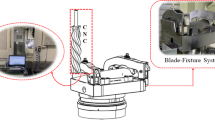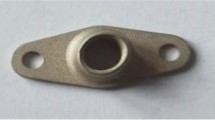Abstract
Acoustic lining assemblies with millions of high-density array holes are key structures for high-performance and low-noise aero-engines. However, the material specificity, variable curvature shape structure, high-order number of holes, and small-sized hole spacing of acoustic lining assemblies pose great challenges to the hole-making technology. In this paper, in view of the machining requirements of millions of acoustic lining holes, a hole matrix unit design method for batch hole making is proposed. The optimal hole matrix unit dimension is calculated with the angle deviation of normal vector as the constraint by matching the structural features of the acoustic lining assembly, dividing and interpolating the hole-making surface, and solving the normal vector of the hole position. The experimental results show that the proposed hole matrix unit design method can effectively control the angle deviation of normal vector of the acoustic lining holes and ensure the processing accuracy of the holes.
















Similar content being viewed by others
Data availability
Not applicable.
Code availability
Not applicable.
References
Lee J (2016) General aviation aircraft design. AIAA J 54(2):793–794
Bai J, Liu S, Wang W (2020) Progress in the airworthiness technology of civil aero-engine. CEAS Aer J: Off J Counc Eur Aer Soc 11(07):1–12
Ma X, Su Z (2020) Development of acoustic liner in aero engine: a review. Sci Chin Technol Sci 63(12):2491–2504
ICAO (2016) Achieving climate change goals for international aviation, ICAO:1–11
Gorji-Bandpy M, Azimi M (2012) Technologies for jet noise reduction in turbofan engines. Aviation 16(1):25–32
Voutsinas SG (2007) Aeroacoustics research in Europe: the CEAS-ASC report on 2005 highlights. J Sound Vib 299(3):419–459
Kempton A (2011) Acoustic liners for modern aero-engines. 15th CEAS-ASC Workshop and 1st Scientific Workshop of X-Noise EV:1–26
Ayle E (2013) Acoustic honeycomb with perforated septum caps. US Patent. US 2012/0037449 A1
Dannemann M, Kucher M, Kunze E (2018) Experimental study of advanced Helmholtz resonator liners with increased acoustic performance by utilising material damping effects. Appl Sci 8(10):1923–1940
Cetinkaya K (2007) A study of the microscopic deformation behavior of an phosphor bronze plate during arbitrary holes piercing process. Mater Des 28(1):294–300
Li G, Yang P, Liang Z, Cui S (2019) Intelligent design and group assembly of male and female dies for hole piercing of automotive stamping dies. Int J Adv Manufact Technol 103(1):665–687
Zhang J, Wang W, Zhang W (2014) Experimental study on high speed electrical discharge machining of carbon fiber-reinforced plastic. Electro Machining & Mould 2:21–24
Chen S (2007) A high-efficiency approach for fabricating mass micro holes by batch micro EDM. J Micromech Microeng 17(10):1961–1961
Teicher U, Müller S, Münzner J (2013) Micro-EDM of carbon fibre-reinforced plastics. Procedia Cirp 6(1):320–325
Geier N, Davim J, Szalay T (2019) Advanced cutting tools and technologies for drilling carbon fibre reinforced polymer (cfrp) composites: a review. Compos A Appl Sci Manuf 125:105552
Aamir M, Tolouei-Rad M, Giasin K, Nosrati A (2019) Recent advances in drilling of carbon fiber reinforced polymers for aerospace applications: a review. International Journal of Advanced Manufacturing Technology
Liu D, Tang Y, Cong W (2012) A review of mechanical drilling for composite laminates. Compos Struct 94(4):1265–1279
Rick C, Steve S, Ian M (2004) Hawde five axis wing surface drilling machine. SAE Trans 113:1413–1417
Benjamen H, Brent T, Stephen W (2006) Composite automatic wing drilling equipment(CAWED). Aer Manufact Automated Fastening Conf Exhibit 01:3162
Jod A, John H, Simon J (2007) Robotic drilling system for 737 aileron. Aer Technol Conf Exp 01:3821
Russell D, Todd S (2010) Applied accurate robotic drilling for aircraft fuselage. SAE Int J Aerosp 3(1):180–186
Magrini A, Benini E, Yao H (2009) A review of installation effects of ultra-high bypass ratio engines. Prog Aerosp Sci 119:100680
He A, Wang J, Gong Q (2020) A batch hole machining tool and method. CN Patent. CN112008460A
Brunet P, Vigo M (1995) Piecewise linear approximation of trimmed surfaces. Geometric Modelling 341–356
Vigo M, Nuria P, Brunet P (1999) Directional adaptive surface triangulation. Comp Aided Geomet Design 16:107–126
Zhang R, Wang G (2004) The error estimates for approximating parametric surface by interpolated plane triangular patch. Math Numer Sin 26(2):169–178
Funding
The work is supported by the National Natural Science Foundation of China (No.51975288).
Author information
Authors and Affiliations
Contributions
Qinghong Gong, conceptualization, investigation, methodology, formal analysis, and writing—original draft. Liang Li, conceptualization, funding acquisition, and supervision. Pan Luo, methodology and writing—review and editing. Jie Chen, investigation and visualization. Xinman Yuan, resources and project administration. Ke Ma, investigation. Zhiqin Hu, visualization.
Corresponding author
Ethics declarations
Ethical approval
The work contains no libelous or unlawful statements, does not infringe on the rights of others, or contains material or instructions that might cause harm or injury.
Consent to participate
The authors consent to participate.
Consent for publication
The authors consent to publish.
Competing interests
The authors declare no competing interests.
Additional information
Publisher's note
Springer Nature remains neutral with regard to jurisdictional claims in published maps and institutional affiliations.
Rights and permissions
Springer Nature or its licensor (e.g. a society or other partner) holds exclusive rights to this article under a publishing agreement with the author(s) or other rightsholder(s); author self-archiving of the accepted manuscript version of this article is solely governed by the terms of such publishing agreement and applicable law.
About this article
Cite this article
Gong, Q., Li, L., Luo, P. et al. Design of hole matrix unit for high-precision batch hole making of acoustic lining assembly of aero-engine. Int J Adv Manuf Technol 124, 1863–1873 (2023). https://doi.org/10.1007/s00170-022-10595-4
Received:
Accepted:
Published:
Issue Date:
DOI: https://doi.org/10.1007/s00170-022-10595-4




